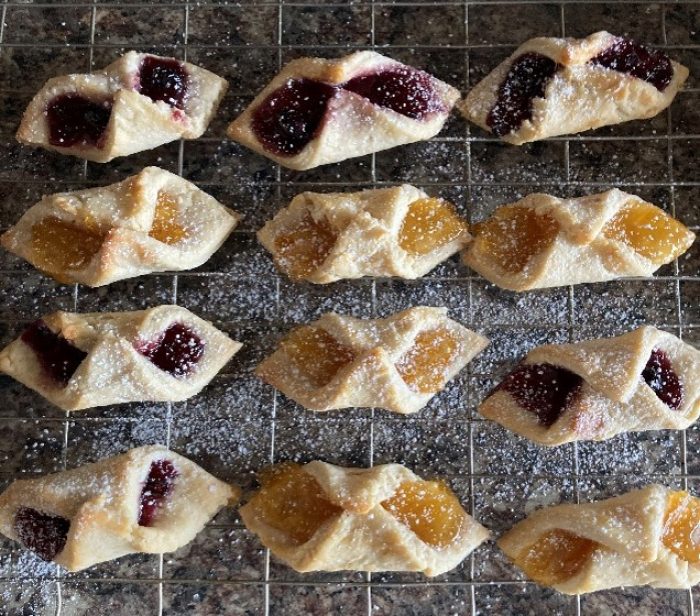These polish cream cheese cookies are perfect served as a dessert or snack.
This is a great recipe to practice some basic baking skills such beating, mixing, forming and shaping dough. If you’re making this in school, or at a cook club, you could pre-make the dough and chill it in the fridge!
Skills Check
Follow a recipe; follow food safety and hygiene rules; tidy away; use a timer; cream fat and cream cheese; scrape out a bowl with a spatula; use measuring spoons; use the oven (with adult supervision).
Equipment
Baking tray, Greaseproof paper, Measuring spoons, Mixing bowl, Wooden spoon, Tablespoon.
Allergens*:
Gluten | Milk | Eggs
(*Please note the allergens listed are indicative only. Allergens vary depending on brand; check the labels on the products you use.)
Ingredients (makes 6 biscuits):
- 15g light cream cheese
- 25g butter (room temperature)
- 50g plain flour
- Apricot and raspberry conserve /pastry filling (not jam)
- 1 tsp Granulated sugar
- 1 tsp Icing sugar
- 1 egg white
Method
- Beat the cheese and butter together in a bowl until light and fluffy
- Add flour in 3 parts mixing well in between
- Bring together to form a dough
- Make into a square, wrap in clingfilm and put in fridge for at least 1 hour.
- Sprinkle the worksurface with 1 teaspoon of sugar and 1 of icing sugar to stop the dough sticking
- Roll out the dough in a square until it is 5mm thick
- Using a knife (or cutter) cut 5 cm squares
- Put ½ teaspoon of filling into the centre of the square
- Brush one of the corners of the dough with egg white, lift it and the opposite corner towards the middle and press together lightly to seal.
- Transfer to baking tray and cook for 15 mins at 180C (170 fan) or until edges are brown.
- Allow to cool, dust with icing sugar to serve
So thinking about Polish kolaczki cookies ...

Nutritional Information
| - | Energy | 311kJ / 74kcal | 4% |
| Med | Fat | 3.3g | 5% |
| Med | Saturates | 1.2g | 6% |
| Med | Sugars | 3.3g | 4% |
| Med | Salt | 0.1g | 2% |
per 25g serving
% of an adult's reference intake
Typical values per 100g: Energy 1297kJ / 310kcal
Notes
A traffic light system is used on nutrition labels to make it easier to see which foods and drinks are lower in calories, fat, sugar and salt. Try and choose more ‘greens’ and ‘ambers’ and fewer ‘reds’, and stick to smaller portions of ‘reds’.
Just because a recipe or a food has a red traffic light doesn’t mean you shouldn’t eat it. Understanding why a food or recipe might have a red light can be helpful. For example oily fish is high in total fat and so any recipe containing oily fish is likely to be ‘red’ for fat. But it is recommended that we eat oily fish at least once a week because the type of fat it contains is beneficial for our health.
% Reference Intakes are also shown. Reference Intakes are guidelines about the approximate amount of particular nutrients and energy required for a healthy diet (based on an average-sized woman doing an average amount of physical activity). Most children will require less than these Reference Intakes. The contribution of one serving of a food or drink to the Reference Intake for each nutrient is expressed as a percentage.



